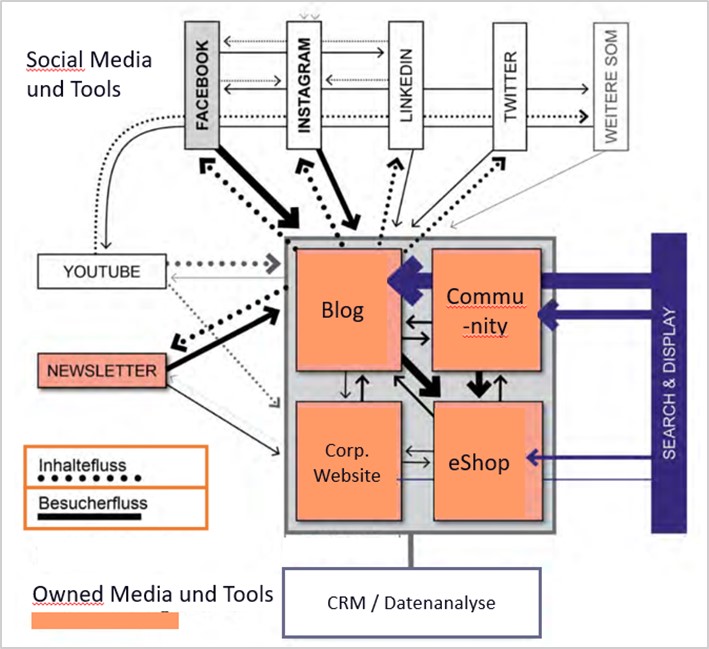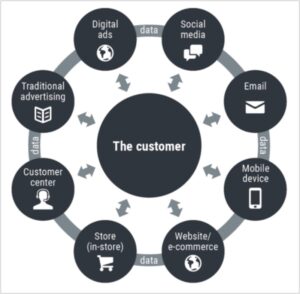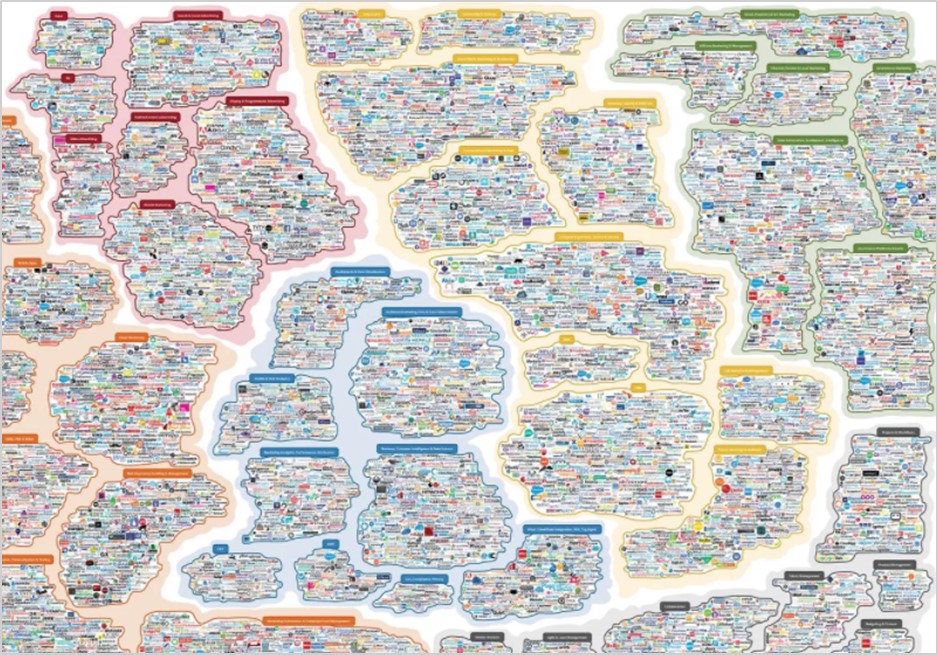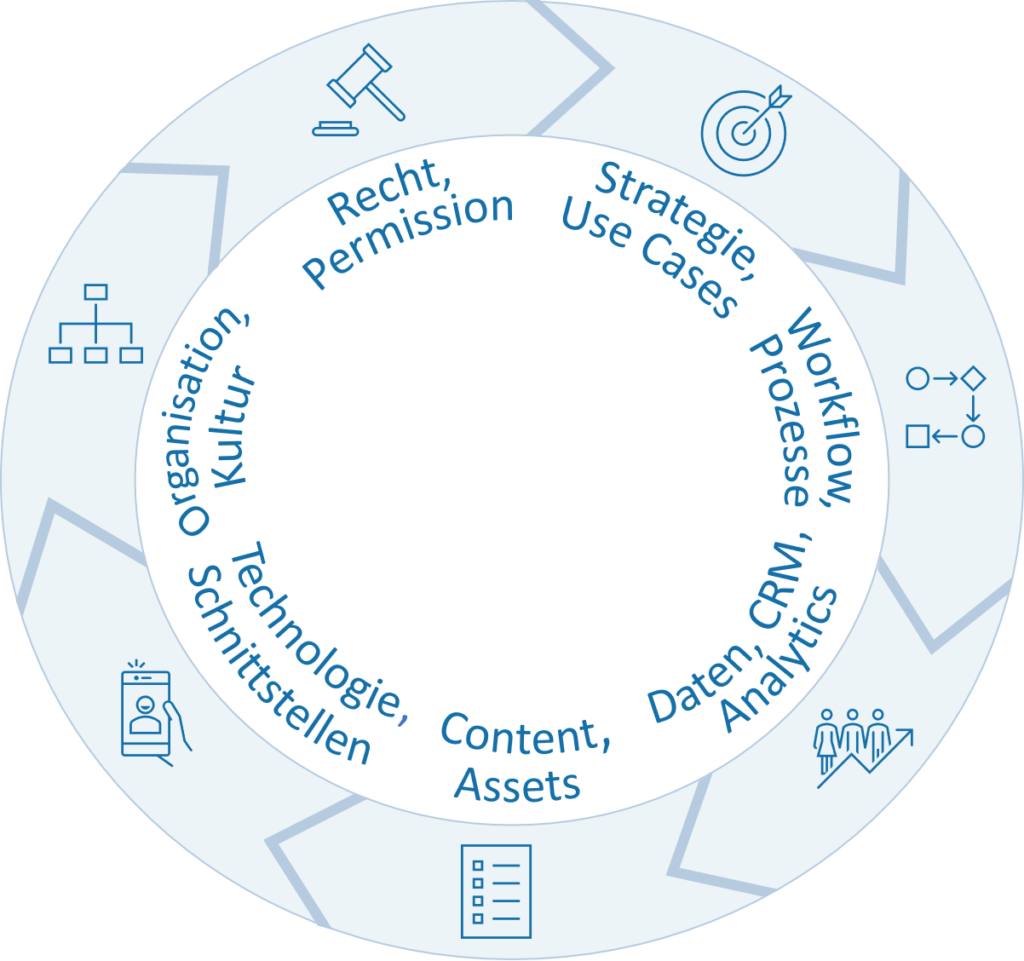Marketing AutomationMarketing Automation ist ein Framework bestehende aus Strategie (First Party Data und Marketing), Use Cases und Prozessen, Daten bzw. Customer Data Platform, Technologien, Inhalten, Organisation und Skills sowie dem Rechtsrahmen bzw. dem Consent Management.... – Technological Wonder Weapon or New Mindset for Effective, Customer-Centric Marketing and More Sales – Part 2
Content and assets:
This sample process of an inbound inquiry in the last chapter includes action points at which a mail is triggered to the target person. These points must be filled with relevant content. And we are already in the middle of the content strategy including the capture and playout of content. Of course, this can be created specifically for a specific channel, e.g. email, but the automation campaign is also often cross-channel; contacts should also be addressed via blogs, social media or even the paid channels.
Content is the origin for all campaigns and touchpoints across the digital channels and therefore also for automation. Content marketing doesn’t exist, but content is the origin so you can drive marketing efforts across diverse channels. The question is, do I want to produce content operationally and campaign-related as before, or do I want to take a step back and play the topic centrally and across all channels?
Does the company have a central content strategy? This is usually driven by current products and services, which a company wants to position in a current period, and content topics, which one wants to cover in the sense of “corporate communication”. From the choice of content topics, marketing planning and response plan can be derived, in which current campaigns and the dissemination of content across multiple channels are presented. These central aspects of a content strategy are only mentioned here in passing.
Where it gets particularly interesting for marketing automationMarketing Automation ist ein Framework bestehende aus Strategie (First Party Data und Marketing), Use Cases und Prozessen, Daten bzw. Customer Data Platform, Technologien, Inhalten, Organisation und Skills sowie dem Rechtsrahmen bzw. dem Consent Management.... is where decisions are made about how content is produced and injected into action items. Is the content produced for a given channel and entered into appropriate templates, or is this done from a central content hub, a content management system (CMS) that is able to adapt content on a channel-by-channel basis and play it out across these channels? You can think of this as a content engine whose purpose should be to input, approve, coordinate between channels, play out and manage content. In the reality of most companies, this is still pure wishful thinking, because their own organization is usually oriented around the channels. Individual departments produce in isolation in their silos, a central content hub is missing and may also often be far too costly and cumbersome to implement or fail due to interfaces. There are usually different systems for the own website, blogs, for newsletters, for social media and as feeds for display advertising and Google Shopping.

From a technical point of view, content is an “asset” that has to be inserted at different points in the communication process for a customer offer. Here are a few examples:
- Texts
- Image formats
- Audio formats
- Video formats
- Links
- HTML5
- Templates, forms, landing pages
- Feeds with product information
Digital asset management and related systems are not discussed further in this white paper, nor are different content formats and an overview of content management systems.
Recommendations:
At this point, we would like to remind you of a few principles that should always apply to good content, even in an automated campaign:
- Timeliness and relevance are “must haves” and increase the user value for the recipient. Thanks to selections, target groups can be filtered out precisely to meet this requirement.
- Making the reader curious always works. If only it were that simple.
- Direct and concise communication reaches the recipient in his short attention span.
- Scarcity of goods or urgency in ordering are permissible, discounts are “no-brainers” but not necessarily desired by the supplier.
- Trying to communicate differently than the others is the desire of every marketer and the basis of every good campaign.
Data and analytics:
Whether data is to be the oil of the 21st century, or merely the basis for artificial intelligence that will actually revolutionize our (marketing) lives, remains to be seen: Without data, in any case, there is no automation. It is the lubricant for the entire workflow. Do you need a lot of data? No, you need exactly one email address, first name, last name, gender; and everything that comes along is useful and improves the options for automation: birthday, purchase transaction data, income, interests, click data, behavioral data.
Let’s try to break it down briefly:
- Structured data is all data that is directly linked to a contact or customer and is stored in an ERP or CRM. For analysis and target group definition, the entire purchase history is particularly relevant.
- Unstructured data is that which is collected via different channels: Anonymous web and social media browsing data is turned into personalized behavioral data via recognition in a sign-up form and is used for further personalization in the automated process; click data in email is the basis for interest attribution, scoring models from user click data qualify leads for marketing and sales, response data is the basis for KPI and feeds a campaign dashboard.

With the combination of both data categories, analysis tools can be alimented so that specialists can identify patterns which they can use in a targeted manner, e.g. as “recommendation” during the purchase process, as “next best offer” after the purchase, as “behavioral modeling” for the identification of target groups and the personalized addressing of concrete users according to their behavior.
Working with structured data is faster and easier. However, the use of the data depends on the goals set by the marketing manager (see chapter Strategy and Use Cases). Segments or profiles can be formed from the transaction data, which can be used specifically for trigger campaigns such as up-selling, cross-selling, retention measures or churn prevention. According to the well-known RFM model (recency, frequency, monetary) in the environment of CRM, certain processes can be triggered in the purchase process when certain thresholds (e.g. turnover, number of purchase transactions, non-purchase over time) are reached. This triggers an automatic customer approach.
In order to merge different data categories (transactions, behavior, clicks), a unified data model is needed. This way, all the right data can be consistently assigned to a given contact. Data sources are unified and data specialists can use simple drag-and-drop methods to click together these data sources and use certain statistical models to validate or reject their hypotheses for marketing objectives. Behind the clicks, SQL queries are run to merge the data. Now we’re in the realm of business intelligence.
The ultimate goal, which is factually unattainable, wants to capture data that can be attributed to leads and customers across all touchpoints in the buying and service process. This results in the famous 360° view of the customer, so that he can be addressed adequately at every point and on every issue. Instead of getting lost in this complexity, focus on a few very simple data and build on them.
And so many ambitious data projects have already failed because rights or consent managementKundendaten sind wertlos, wenn die Berechtigung zur Nutzung dieser Daten zu Marketingzwecken nicht konsequent zum jeweiligen Kontakt abgelegt werden und dieser rechtliche Status nicht laufend gepflegt wird. Technisch bedeutet eine Einwilligung... was neglected (see the Legal chapter). If you can’t obtain and differentiate permission to use personalized data for marketing purposes cleanly and across all channels, you can’t run an automated multi-channel campaign.
Dashboards for data visualization and evaluation of cross-channel activities are becoming increasingly important. However, KPIs such as impressions/deliveries – reach/opens – clicks/engagement – conversion/revenue are not uniformly defined and are very difficult to compare across channels. You can try to build such an overview together in Google’s Data Studio. Act according to the rules of experiment – measure – improve and optimize. ROI considerations are inevitable.
Recommendations:
- Think about which data you want to make usable in the long term, whether it is already available or should be made available in addition.
- Create a privacy policy that provides information about the use of the data. The same applies to the use of cookies. The opt-in process for e-mail marketing should be set up in such a way that it is clearly verifiable.
- Identify simple, structured data and plan initial walk-throughs of non-complex use cases. Don’t be fooled into thinking you lack a lot of data to make sense of. Understanding increases with use.
- Enrich customer data on preferences and interests and validate these attributes regularly. Data is only as good as it is regularly stored, maintained, used and analyzed. Artificial intelligence can help you do this.
Technologies and interfaces:
I repeat: Technologies can do a lot, very much. But without the clear objective, the simplicity of operation, the necessary skills to want to operate the technology, they are not purposeful and too expensive. And only the user can change that. Technology must match the maturity of marketing communications and must fit into the budget. It is frightening how large companies pay very high licenses for technology and only use basic functionalities.
If you look at the MarTech landscape of the last 20 years, you see exorbitant growth and therefore total fragmentation. 20% of the technologies did not exist a year ago. How is one supposed to keep track in this market?

Two technology trends have been emerging for several years:
Large vendors are forming, such as Salesforce, Oracle, Adobe, and even SAP, which are trying to integrate (almost) all aspects of this white paper on one powerful platform and fully lock in the customer. Mostly the technologies are bought together, which doesn’t mean the customer can use them seamlessly, but time and development speak for the platform providers. The offerings are found almost exclusively in the cloud. “On premise” hosting is taking a back seat because it is too labor intensive and too complicated to handle updates. With effective data protectionIt is not enough for companies to aggregate your users' data. They must also obtain permission to use this data at the same time. They must obtain an overview of whether and for what purpose they may actively use this personal data or use it for advertising... regulations and data security standards, the cloud is also becoming more attractive, and the last emotional hurdle for traditional managers is disappearing.
The following content modules are part of a complete marketing platform:
- CRM functionalities and those within the scope of service provision
- Tracking functionalities to respond to browsing and click behavior
- Lead generation and scoring model for qualifying leads until conversion by the sales department
- Journey Builder for the creation of automated and process-oriented campaigns, mostly based on email templates
- Campaign management for handling campaigns via email, SMS, web push, app, social media, social media and Google Ads, and display
- Possibly a content management system that serves as a central content hub for content production and playout
- Possibly a data management platform DMP to capture and store all relevant data
- Possibly a data visualization tool with dashboard functions for countless evaluations
- Possibly an analytics tool or audience manager for data analyses and target group selections with statistical means
- Possibly a store technology for the collection and playout of countless products as part of the purchase process
- Possibly social listening and content media systems for optimal management of social channels
- Interface software to easily connect external and already existing systems to the modules of the Marketing CloudEine Marketing Cloud Technologie umfasst verschiedene Module für die aktive Bewirtschaftung und Dialogführung von Kunden über eine digitale Marketing Plattform, welche selbst als SaaS-Dienstleistung - also über das Internet und nicht proprietär im eigenen...
The second trend involves the “category leaders” or is called “best-of-breed”:
It is rare to start on the famous green field when introducing marketing technologies. Most companies have a “legacy”, i.e. diverse systems that have grown over the years and are difficult to replace. And integrating marketing clouds are often impossible to introduce in a company because of diverging internal interests. So attempts are made to selectively introduce new niche products with proven functionality and user-friendliness and to connect these systems to the existing landscape via APIs, connectors and interface software where this makes sense. Technologically, this approach is certainly more demanding, but it also tends to be less expensive. For IT managers, it becomes more difficult to maintain an overview as systems become increasingly fragmented. And the old saying is still true: You don’t get fired if you buy a big name; the “insurance” comes with it, but it has its price.
Recommendations:
- Don’t look for a “features and functionality” list on the Internet that is supposed to replace the task of defining your own requirements. Think about what you really (will) need, not what all the technology seems to offer.
- Whatever you choose, find an ecosystem that is comprehensive enough for you to evolve. Open interfaces and/or an App Exchange, where developers flock and where other useful apps can be found, will help connect to your existing system landscape.
- Have both approaches (platform and “best of breed”) presented to you. You will always find providers and their implementation partners who can map concrete use cases on the system for you and then introduce the technology. A good implementer is at least as important as the technology itself.
- Treat vendors correctly. It has become a bad habit to have technologies demonstrated to you with a huge pre-sales effort to compensate for your own lack of know-how for free, and then change the rules of the game for the RFP as you become more enlightened. You may build a learning curve, but not at the endless expense of technology providers and especially serious implementation service providers.


